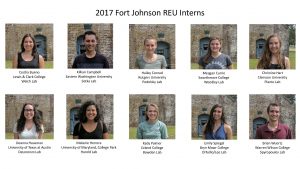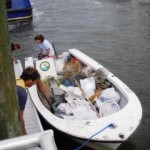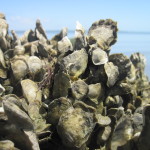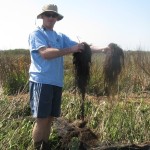Grice Marine Lab hosted ten students for the 2017 Fort Johnson Summer Research Experience for Undergraduates (REU) Program. They arrived May 31st, hit the ground running, worked for ten weeks, and closed the program with exceptional presentations on August 9th. Each intern was paired with a mentor on the Fort Johnson campus to develop and execute a research project on the program theme of “Marine Organism Health: Resilience and Response to Environmental Change.” Along the way, the interns learned how to share their research in weekly workshops on science communication led by Carolyn Sotka. The program also included lectures, field trips and professional training for careers in science.
Here are the interns, their home institution and mentor lab
(click to enlarge)
- Cecilia Bueno (Lewis & Clark College). The effects of salinity on sperm function and fertilization in Squirrel Treefrogs (Hyla squirella).
Mentor: Allison Welch, PhD (CofC) - Killian Campbell (Eastern Washington University). The role of heat shock proteins 70 and 90 in tolerating abiotic stressors in the seaweeds Gracilaria vermiculophylla and Ulva lactuca. Mentors: Erik Sotka, PhD and Ben Flanagan (CofC)
- Hailey Conrad (Rutgers University). Genetic variation in resistance to ocean acidification during larval development in a northern population of the sea urchin Arbacia punctulata.
Mentor: Robert Podolsky, PhD (CofC) - Meagan Currie (Swarthmore College). A toxicological investigation of the effects of 4-nonylphenol on the coral Acropora cervicornis.
Mentors: Cheryl Woodley, PhD and Natasha White, PhD (NOAA) - Christine Hart (Clemson University). Dynamics of benthic diatom communities: patterns in biomass and composition.
Mentors: Craig Plante, PhD and Kristy Hill-Spanik, MS (CofC) - Deanna Hausman (U. of Texas at Austin). Toxic effects of oil and UV light on the estuarine shrimp Palaemonetes pugio.
Mentors: Marie Delorenzo, PhD and Paul Pennington, PhD (NOAA) - Melanie Herrera (U. of Maryland, College Park). Comparison of fish populations in dense and sparse assemblages of the invasive seaweed Gracilaria vermiculophylla.
Mentors: Tony Harold, PhD and Mary Ann McBrayer (CofC) - Kady Palmer (Eckerd College). Perfluoroalkyl acids (PFAAs) in plasma of the West Indian Manatee (Trichechus manatus).
Mentor: John Bowden, PhD (NIST) - Emily Spiegel (Bryn Mawr College). Getting in the mood: the effect of environmental stress on the reproduction and productivity of a polar diatom.
Mentors: Peter Lee, PhD and Nicole Schanke, MS (CofC) - Brian Wuertz (Warren Wilson College). Investigating the potential of dioctyl sodium sulfosuccinate (DOSS) to promote inflammatory response in macrophage.
Mentor: Demetri Spyropoulos, PhD (MUSC)
Visit the blog written by the interns to read about the projects and see their progression over the summer: Marine Organism Health: Resilience and Response to Environmental Change
Many thanks to Bob Podolsky, Director, Ft. Johnson Summer REU Program, College of Charleston and Carolyn Sotka, Science Communication Workshop Series, Ft. Johnson REU Program.
Thanks also go to all the mentors and contributing partner institutions at Ft. Johnson: the Medical University of South Carolina (MUSC), the National Oceanographic and Atmospheric Administration (NOAA), the National Institute of Standards and Technology (NIST), the South Carolina Department of Natural Resources (SCDNR).
This program is supported by NSF Award No. DBI-1359079
Congrats and great job 2017 Fort Johnson REU Interns!










